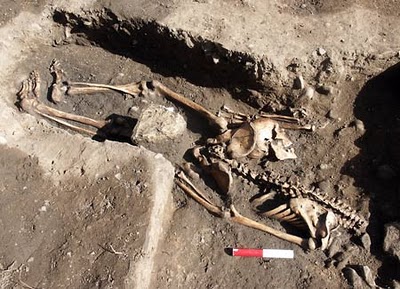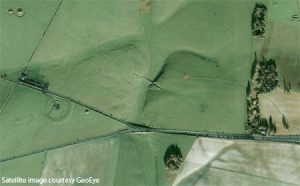 A 5,500-year-old leather shoe has been found in a cave in Armenia. The shoe 1,000 years older than Giza’s Great Pyramid and 400 years older than Stonehenge is perfectly preserved and was found complete with shoelaces. It is believed to be the oldest example of enclosed leather footwear, out-dating the shoes worn by Otzi the Iceman by a few hundred years.
A 5,500-year-old leather shoe has been found in a cave in Armenia. The shoe 1,000 years older than Giza’s Great Pyramid and 400 years older than Stonehenge is perfectly preserved and was found complete with shoelaces. It is believed to be the oldest example of enclosed leather footwear, out-dating the shoes worn by Otzi the Iceman by a few hundred years.
The shoe is sole-less, made out of a single piece of cow hide and was shaped to the wearer’s right foot. It contained grass, which might have served to either keep the foot warm or to maintain the shape of the shoe. It is not known whether the shoe 24.5cm long and a European size 37 belonged to a man or a woman, though it would have been ideal for a male of that era.
The shoe is similar to the ‘pampootsies’ worn until the 1950s on Irelands Aran Islands. In fact, enormous similarities exist between manufacturing technique and style of this shoe and those found across Europe at later periods, suggesting that this type of shoe was worn for thousands of years across a large and environmentally diverse geographic region, said Dr Ron Pinhasi of Cork University.
Such a well-preserved artifact from a Middle Eastern archaeological site is considered an amazing find because organic materials usually deteriorate due to the high content of salts and fungi in the soil, as well as fluctuations in temperature and humidity.
The discovery was made in Vayotz Dzor province on Armenias border with Iran and Turkey by Diana Zardaryan of Armenias Institute of Archaeology. I was amazed to find that even the shoelaces were preserved, she said.
The stable, cool and dry conditions in the Areni-1cave resulted in the exceptional preservation of the shoe and other objects. Other finds included large containers, many of which held well-preserved wheat, barley, apricots and other edible foodstuffs.
A thick layer of sheep dung covered the floor of the cave, sealing the artefacts and archaeological deposits and further assisting preservation. Other discoveries included a broken pot, fishbones and sheep’s horns.
We couldn’t believe the discovery, said the dig’s co-director Gregory Areshian, part of an international team of archaeologists working at the site. The crusts had sealed the artefacts and archaeological deposits and artefacts remained fresh dried, just like they were put in a can.
Both the shoe and the grass samples were shown to be the same age, and dated to the Chalcolithic period, about 3500BC.
While the Armenian discovery is believed to be the oldest recorded example of a leather shoe and the oldest Eurasian shoe it is not the oldest known footwear. Predating the shoe by as many as 2,000 years are a moccasin made of plant material and a pair of leather sandals discovered in the 1970s in a cave in Missouri.
Leather sandals of a similar age to the Areni-1 shoe were found in a cave in Israels Judean Desert but these were never directly dated. Rather, their age is based on various other associated artefacts found in the Cave of the Warriors.
The archaeologists have not yet identified the purpose of the cave.”We know that there are children’s graves at the back of the cave but so little is known about this period that we cannot say with any certainty why all these different objects were found together,” said Dr Pinhasi.The international team will continue to excavate the many chambers of the cave.
The same team last year announced the find ofthe ‘world’s oldest human brain’ at the Areni-1 site, a 9 by 7 centimetres brain fragment, possible evidence of ceremonial cannibalism as well as a large number of vessels and grapevine shoots (possibly the ‘world’s oldest commercial winery’).
Further details on the study of the Areni-1shoeare published in the online scientific journal PloS ONE as First Direct Evidence of Chalcolithic Footwear from the Near Eastern Highlands.









